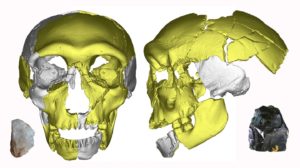
PROCEEDINGS OF THE NATIONAL ACADEMY OF SCIENCES—Excavations in Middle Pleistocene cave deposits in southeastern China yielded a skull that exhibits morphological similarities to other East Asian Middle and Late Pleistocene archaic human remains but foreshadows later modern human forms, according to a study*. Fossil evidence for human evolution in East Asia during the Pleistocene is often fragmentary and scattered, complicating efforts to evaluate the pattern of archaic human evolution and modern human emergence in the region. Xiu-Jie Wu and colleagues report the discovery of most of a skull and associated remains, dating to around 300,000 years ago, in Middle Pleistocene cave deposits of Hualong Cave in southeastern China. The features of the Hualong fossils complement those of other East Asian fossil remains, indicating a continuity of form through the Middle Pleistocene and into the Late Pleistocene. In particular, the skull features a low and wide braincase with a projecting brow but a relatively flat midface, as well as an incipient chin. The teeth are simple in form, contrasting with other archaic East Asian fossils, and its third molars are either reduced in size or absent. According to the authors, the fossil remains add to the expected variation of these Middle Pleistocene humans, recombining features present in other individuals from the same time-period, and foreshadow developments in modern humans, providing evidence for regional continuity.
_______________________________

The Hualongdong Middle Pleistocene human skull and the collapsed cave site, with the fossil-bearing breccia in beige around the limestone blocks. Xiu-Jie Wu and Erik Trinkhaus
_______________________________

This is the virtual reconstruction of the Hualongdong 6 human skull, with mirror-imaged portions in gray, plus two of the few stone tools from the site. Xiu-Jie Wu and Erik Trinkhaus
_______________________________
*”Archaic human remains from Hualongdong, China, and Middle Pleistocene human continuity and variation,” by Xiu-Jie Wu et al.
Article Source: PROCEEDINGS OF THE NATIONAL ACADEMY OF SCIENCES news release.
____________________________
See, first-hand, the original fossils. See original artifacts. See the actual sites. Talk with the famous scientists. Join us on this unique specialized study tour.
____________________________





